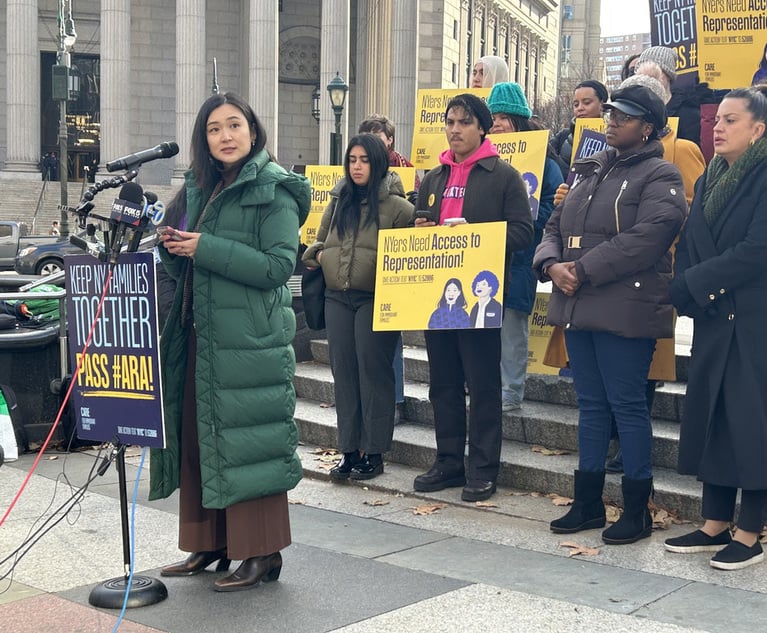In Domicile Case, Tax Department Takes Another 'Bizarro' Position
In their Tax Appeals Tribunal column, Joseph Lipari and Aaron S. Gaynor discuss a recent personal income tax domicile case in which the New York State Tax Department made arguments contrary to those it normally takes. It provides a useful reminder for those looking to move into New York on a “temporary” basis to make sure their filings are consistent, and to avoid press showcasing the extent of their apartment renovations.
June 13, 2019 at 12:30 PM
9 minute read
 In this column four years ago, we described a situation where the New York State Tax Department argued a position in two corporate cases (i.e., that the corporations should be required to file separate franchise tax returns rather than combined returns) almost exactly contrary to the position ordinarily taken by the Department. Referencing the Seinfeld episode, “The Bizarro Jerry,” we explained that the Department's position created “a funny sense of unease as everything you had come to expect is different.” In a recent personal income tax domicile case, Grant G. Biggar, DTA No. 827817 (N.Y. Div. Tax App., Jan. 10, 2019), the Department again made arguments contrary to those it normally takes.
In this column four years ago, we described a situation where the New York State Tax Department argued a position in two corporate cases (i.e., that the corporations should be required to file separate franchise tax returns rather than combined returns) almost exactly contrary to the position ordinarily taken by the Department. Referencing the Seinfeld episode, “The Bizarro Jerry,” we explained that the Department's position created “a funny sense of unease as everything you had come to expect is different.” In a recent personal income tax domicile case, Grant G. Biggar, DTA No. 827817 (N.Y. Div. Tax App., Jan. 10, 2019), the Department again made arguments contrary to those it normally takes.
Unsurprisingly, domicile audits and litigation in New York overwhelmingly involve individuals who were previously domiciled in New York but claim to have changed their domicile to Florida or some other low tax jurisdiction. (See, for example, the somewhat recent cases of Gregory Blatt, DTA No. 826504 (N.Y. Div. Tax App., Feb. 2, 2017), and Stephen C. Patrick, et al., DTA Nos. 826838, 826839 (N.Y. Div. Tax App., June 15, 2017, both discussed in this column.) In Biggar, by contrast, the Department argued that petitioner adopted New York as his domicile in 2010. (The case also involved the petitioner's claim that he also became domiciled in New Zealand in 2014.)
For the duration of his adult life up until 2002, the taxpayer bounced (mainly) among cities in New Zealand, Sydney, London, and New York City. From 2002 until 2010, petitioner lived in London. In 2010, petitioner accepted a position as president of “Creditex,” his longtime employer. The position required relocation to New York City.
Petitioner testified that he did not view his new role as “permanent,” as his principal responsibility was to integrate Creditex into its new parent corporation. Petitioner's employment contract was for an initial one-year term, which thereafter automatically renewed every six months unless otherwise terminated. Although initially in the United States under a “management transfer” visa, petitioner applied for permanent resident status (i.e., a “green card”), which was granted in 2012.
Shortly before he moved to New York City, petitioner purchased an apartment in the West Village for $2.9 million. He then undertook a $600,000-$700,000 renovation. The renovation was the subject of an article in a New Zealand magazine, which noted that petitioner was “particularly involved” in the furnishing of the apartment. In London, petitioner had rented, rather than owned a home.
Petitioner left his position as president of Creditex at the end of 2012. Petitioner thereafter became an investor in, and advisor to, assorted start-ups located around the world. However, petitioner noted that, in New York, he could stay connected to the “great ecosystem … for start-up businesses.” Although he traveled extensively, he would generally return to New York City between trips. In 2014, due to the illness and subsequent death of his mother, petitioner spent a material amount of time in New Zealand. Around the time of his mother's death, and, in part, to reconnect with his estranged father, petitioner purchased a home in New Zealand.
With respect to 2010, petitioner filed Form IT-203, a nonresident and part-year resident income tax return, along with Form IT-360.1, a form that indicates a taxpayer's change in domicile into or out of New York City. Petitioner's tax preparer for 2010 did not testify and petitioner did not give a reason why that tax preparer could not testify. Petitioner's current tax preparer testified, stating that “he would not have filed the IT-360.1 with the 2010 return.” The current tax preparer testified that he filed petitioner's 2012, 2013, and 2015 returns using Form IT-201 (for full-time residents) on the basis that petitioner was a statutory resident, and not a domiciliary. Petitioner's 2014 return was filed on the basis of being a nonresident. The administrative law judge (ALJ) agreed with the Department's position that petitioner was in fact a New York domiciliary in 2014, as petitioner acquired New York as his domicile in 2010, and failed to relinquished it.
N.Y. Tax Law §601 generally imposes tax on all income of a New York State individual resident. New York Tax Law §605(b)(1) generally provides that the definition of individual resident includes a person (A) “who is domiciled in” New York State (a “domiciliary”), or (B) who “maintains a permanent place of abode” in, and spends 183 days in a year in, New York State (a “statutory resident”). Paragraph (1) of 20 N.Y.C.R.R. §105.20(d) provides that “[d]omicile, in general, is the place which an individual intends to be such individual's permanent home—the place to which such individual intends to return whenever such individual may be absent” (emphasis added). Paragraph (2) provides that “[a] domicile once established continues until the person in question moves to a new location with the bona fide intention of making such individual's fixed and permanent home there. No change of domicile results from a removal to a new location if the intention is to remain there only for a limited time; this rule applies even though the individual may have sold or disposed of such individual's former home” (emphasis added). Paragraph (3) provides “a United States citizen will not ordinarily be deemed to have changed such citizen's domicile by going to a foreign country unless it is clearly shown that such citizen intends to remain there permanently.” This rule is a correlative to a case law doctrine setting a higher burden to show change of domicile to another country. See, e.g., McKone v. State Tax Commission of the State of New York, 111 A.D.2d 1051 (3d Dep't 1985).
With respect to burdens of proof, paragraph (2) provides that “[t]he burden is upon any person asserting a change of domicile to show that the necessary intention existed.” The Department's Nonresident Audit Guidelines are explicit that “the Department bears the burden of proof to show that an individual who was previously a non-domiciliary of New York changed his domicile to New York,” which must be met by a showing of “clear and convincing” evidence.
In framing his analysis of petitioner's intent, the ALJ quoted extensively from McKone v. State Tax Commission of the State of New York, 111 A.D.2d 1051 (3d Dep't 1985). McKone concerned an employee of an Albany-based company. The nature of the taxpayer's job required relocation from time to time, including, in this instance, a move to Quebec. The taxpayer severed ties with New York, including selling his home, changing bank accounts, and ceasing to vote in New York. Several years later he returned to New York, at which point the Department asserted that he had never relinquished his New York domicile, on the theory that he intended to return and did not intend to stay in Quebec permanently. The Department argued that, given taxpayer's regular relocation, he did not have the intent to stay in Quebec, and, therefore, remained a New York domiciliary. The McKone court clarifies that, for these purposes, permanent is meant in contrast to “temporary,” and not necessarily to mean eternal. The court found that it was sufficient that the taxpayer to have an indefinite intent to stay (that is, an intent to stay for an indeterminate amount of time) for purposes of establishing a new domicile.
Determining an individual's intent as to where he is domiciled is inherently difficult. In cases where the taxpayer is claiming an intent to change his domicile outside New York, the taxpayer will often mention certain steps he has taken, such as the filing of a declaration of domicile or the changing of voter registration, driver's license, etc. In many cases, the Department dismisses the significance of such evidence. In this “bizarro” case, however, the Department is relying on the same documentation it usually rejects.
Notwithstanding this evidentiary advantage, the petitioner in Biggar was still unable to overcome the evidence against his position. The crux of the ALJ's determination was the filing of a Form IT-360.1, on which petitioner declared himself a New York City domiciliary. The ALJ found that the current tax preparer's testimony that the Form IT-360.1 was filed in error “strains credulity,” particularly because the preparer who filed the form did not testify. This meant that, although the filing of the form was not dispositive in and of itself, petitioner needed to present additional evidence “sufficient to counter the evidentiary weight of his filing” of the form. The ALJ held that petitioner failed to do so.
Like most domicile cases, Biggar largely turned on the taxpayer's testimony. Specifically, the ALJ noted that “[p]etitioner offered no testimony regarding how long he planned on staying in New York upon moving there in 2010. He depicted his job as president of Creditex, which required him to be in New York City, as temporary, but he did not say that it was his intention at the end of that employment to leave New York City.” The ALJ continues, “petitioner did not even mention the possibility of leaving New York City to return permanently to New Zealand.” This is to say that whether or not petitioner intended to stay in New York forever, he intended to stay for an indefinite tenure.
As the ALJ noted, even if petitioner had the correct subjective intent (to stay only for a limited duration), he “must prove … the objective manifestation of that intent displayed through his conduct” (internal citations omitted). The ALJ notes that petitioner obtained a green card, even though he viewed the Creditex job as temporary. Moreover, before petitioner began his new job, he purchased a home in New York City, whereas, in London, he had rented. Seemingly, the petitioner neither owned nor rented any other homes at the time of the purchase. The ALJ acknowledged that petitioner had accumulated greater financial resources by the time he moved to New York City, but found that a “major renovation is more consistent with an intention to stay indefinitely than for a short and finite time.” Lastly, during post-Creditex period, petitioner would return to New York City between trips abroad.
Even without bearing the burden of proof, petitioner was unable to prevail. However, if nothing else, his case is a useful reminder for those looking to move into New York on a “temporary” basis to make sure their filings are consistent, and to avoid press showcasing the extent of their apartment renovations.
Joseph Lipari is a partner and Aaron S. Gaynor is an associate at the law firm of Roberts & Holland.
This content has been archived. It is available through our partners, LexisNexis® and Bloomberg Law.
To view this content, please continue to their sites.
Not a Lexis Subscriber?
Subscribe Now
Not a Bloomberg Law Subscriber?
Subscribe Now
NOT FOR REPRINT
© 2025 ALM Global, LLC, All Rights Reserved. Request academic re-use from www.copyright.com. All other uses, submit a request to [email protected]. For more information visit Asset & Logo Licensing.
You Might Like
View All
So Who Won? Congestion Pricing Ruling Leaves Both Sides Claiming Victory, Attorneys Seeking Clarification
4 minute read
Hochul Vetoes 'Grieving Families' Bill, Faulting a Lack of Changes to Suit Her Concerns

Court System Names New Administrative Judges for New York City Courts in Leadership Shakeup
3 minute read
Trending Stories
- 1How to Litigate Before the EU’s Top Court, the European Court of Justice
- 2After Solving Problems for Presidents, Ron Klain Now Applying Legal Prowess to Helping Airbnb Overturn NYC Ban
- 3Attorneys Allege Contract Broken for Sharing $13M in Fees From MDL
- 4ZwillGen Acquires Lawyers, Scientists and Technology from Luminos.Law, Developer of Luminos.AI Platform
- 5Clifford Chance Strengthens Private Credit Offering With Mayer Brown Partners
Who Got The Work
Michael G. Bongiorno, Andrew Scott Dulberg and Elizabeth E. Driscoll from Wilmer Cutler Pickering Hale and Dorr have stepped in to represent Symbotic Inc., an A.I.-enabled technology platform that focuses on increasing supply chain efficiency, and other defendants in a pending shareholder derivative lawsuit. The case, filed Oct. 2 in Massachusetts District Court by the Brown Law Firm on behalf of Stephen Austen, accuses certain officers and directors of misleading investors in regard to Symbotic's potential for margin growth by failing to disclose that the company was not equipped to timely deploy its systems or manage expenses through project delays. The case, assigned to U.S. District Judge Nathaniel M. Gorton, is 1:24-cv-12522, Austen v. Cohen et al.
Who Got The Work
Edmund Polubinski and Marie Killmond of Davis Polk & Wardwell have entered appearances for data platform software development company MongoDB and other defendants in a pending shareholder derivative lawsuit. The action, filed Oct. 7 in New York Southern District Court by the Brown Law Firm, accuses the company's directors and/or officers of falsely expressing confidence in the company’s restructuring of its sales incentive plan and downplaying the severity of decreases in its upfront commitments. The case is 1:24-cv-07594, Roy v. Ittycheria et al.
Who Got The Work
Amy O. Bruchs and Kurt F. Ellison of Michael Best & Friedrich have entered appearances for Epic Systems Corp. in a pending employment discrimination lawsuit. The suit was filed Sept. 7 in Wisconsin Western District Court by Levine Eisberner LLC and Siri & Glimstad on behalf of a project manager who claims that he was wrongfully terminated after applying for a religious exemption to the defendant's COVID-19 vaccine mandate. The case, assigned to U.S. Magistrate Judge Anita Marie Boor, is 3:24-cv-00630, Secker, Nathan v. Epic Systems Corporation.
Who Got The Work
David X. Sullivan, Thomas J. Finn and Gregory A. Hall from McCarter & English have entered appearances for Sunrun Installation Services in a pending civil rights lawsuit. The complaint was filed Sept. 4 in Connecticut District Court by attorney Robert M. Berke on behalf of former employee George Edward Steins, who was arrested and charged with employing an unregistered home improvement salesperson. The complaint alleges that had Sunrun informed the Connecticut Department of Consumer Protection that the plaintiff's employment had ended in 2017 and that he no longer held Sunrun's home improvement contractor license, he would not have been hit with charges, which were dismissed in May 2024. The case, assigned to U.S. District Judge Jeffrey A. Meyer, is 3:24-cv-01423, Steins v. Sunrun, Inc. et al.
Who Got The Work
Greenberg Traurig shareholder Joshua L. Raskin has entered an appearance for boohoo.com UK Ltd. in a pending patent infringement lawsuit. The suit, filed Sept. 3 in Texas Eastern District Court by Rozier Hardt McDonough on behalf of Alto Dynamics, asserts five patents related to an online shopping platform. The case, assigned to U.S. District Judge Rodney Gilstrap, is 2:24-cv-00719, Alto Dynamics, LLC v. boohoo.com UK Limited.
Featured Firms
Law Offices of Gary Martin Hays & Associates, P.C.
(470) 294-1674
Law Offices of Mark E. Salomone
(857) 444-6468
Smith & Hassler
(713) 739-1250






